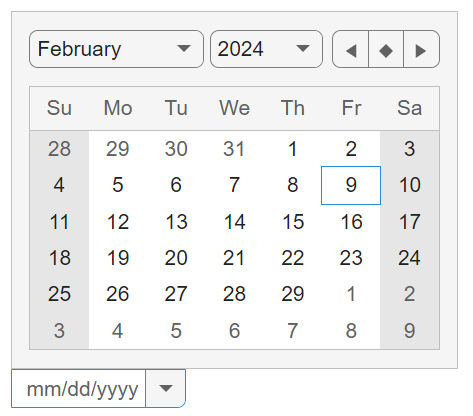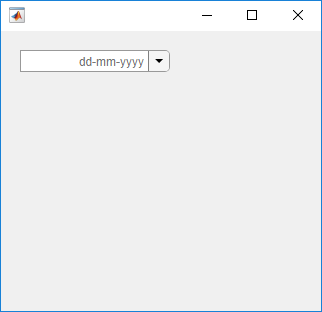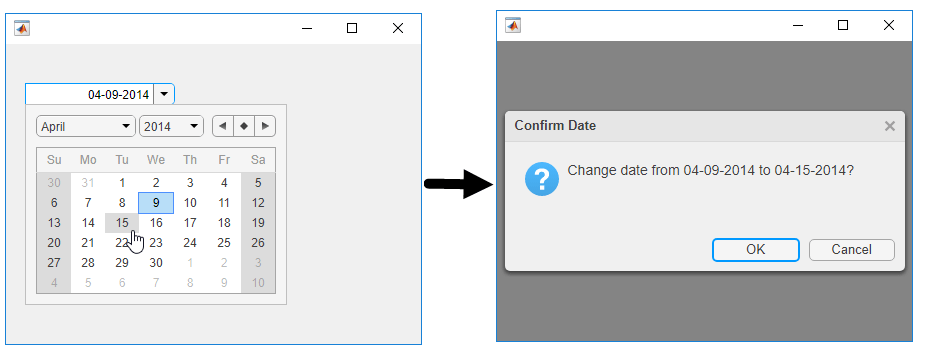DatePicker
日期选择器 UI 组件

说明
日期选择器 UI 组件允许 App 用户从交互式日历中选择日期。在创建日期选择器后,使用 DatePicker 对象修改其外观和行为。
创建对象
使用 uidatepicker 函数在 App 中创建一个日期选择器。
属性
日期选择器
占位符文本,指定为字符向量或字符串标量。占位符提供简短的提示来说明预期的输入。仅当 Value 属性为 NaT 时,文本才会显示。
示例: 'aaaa/mm/dd'
选择范围,指定为 1×2 datetime 数组。此数组中的第二个值必须晚于第一个值。默认值为 [datetime(0000,1,1) datetime(9999,12,31)]。此默认值从尽可能早的日期开始,并在 DatePicker 支持的最晚可能日期结束。
在正在运行的 App 中,日期选择器允许用户在此属性定义的闭区间内选择日期。如果该区间内有禁用的日期,这些日期将被排除。
示例: d = uidatepicker('Limits',[datetime('today') datetime(2050,1,1)])
数据类型: datetime
日期选择器文本字段的显示格式,指定为字符向量或字符串标量。默认格式取决于运行 App 的系统的区域设置。
您指定的格式必须使用有效的字母标识符,这些标识符要符合关于日期和时间的 Unicode® 区域设置数据标记语言 (LDML) 标准。要分隔字段,可以包括非字母字符,例如连字符、空格、冒号或任何非 ASCII 字符。
示例: d = uidatepicker('DisplayFormat','dd/MM/yy')
常用格式示例
下表列出了常用的显示格式。以下示例说明 2014 年 4 月 9 日星期三的格式化输出。
Format 的值 | 示例 |
|---|---|
'yyyy-MM-dd' | 2014-04-09 |
'dd/MM/yyyy' | 09/04/2014 |
'dd.MM.yyyy' | 09.04.2014 |
'yyyy年 MM月 dd日' | 2014年 04月 09日 |
'MMMM d, yyyy' | April 9, 2014 |
所有日期和时间格式
使用这些字母标识符创建显示格式。下表第三列显示 2014 年 4 月 9 日星期三的输出。
| 字母标识符 | 描述 | 显示 |
|---|---|---|
G | 年代 | CE |
y | 年份,没有前导零。 | 2014 |
yy | 年份,使用最后两位数。 | 14 |
yyy, yyyy ... | 年份,至少使用与 'y' 实例相同的位数 | 对于年份 2014,'yyy' 显示 2014,而 'yyyyy' 则显示 02014。 |
u, uu, ... | ISO 年份,指示年份的单个数字。 | 2014 |
Q | 季度,使用一位数 | 2 |
QQ | 季度,使用两位数 | 02 |
QQQ | 季度,缩写 | 2 季度 |
QQQQ | 季度,全名 | 第二季度 |
M | 月份,使用一位或两位数字的数值 | 4 |
MM | 月份,使用两位数字的数值 | 04 |
MMM | 月份,缩写名称 | 四月 |
MMMM | 月份,全名 | 四月 |
MMMMM | 月份,首字母大写 | A |
W | 一月中的第几周,使用一位数 | 2 |
d | 一月中的第几天,使用一位或两位数 | 9 |
dd | 一月中的第几天,使用两位数字 | 09 |
D | 一年中的第几天,使用一位、两位或三位数 | 99 |
DD | 一年中的第几天,使用两位数字 | 99 |
DDD | 一年中的第几天,使用三位数 | 099 |
e | 一周中的第几天,使用一位或两位数字的数值 | 4,星期日是一周中的第一天 |
ee | 一周中的第几天,使用两位数字的数值 | 04 |
eee | 星期几,缩写名称 | Wed |
eeee | 星期几,全名 | Wednesday |
eeeee | 星期几,使用一位大写数字 | W |
注意
即使
DisplayFormat包含单词,正在运行的 App 中的编辑字段也接受分隔数值。例如,如果月份格式指定为'MMMM',App 也会接受数值形式的月份(如04),但会将其显示为月份名称(如'April')。如果用户在正在运行的 App 中指定日期数字,而格式中同时包含日期 (
D) 和格里历年 (y) 的标识符,则datetime可能无法正确读取日期数字。请使用 ISO 年份 (u) 来代替y。使用一个或多个
u字符而非y字符在使用接近零的年份数时解释年份。
禁用的日期,指定为 m×1 datetime 数组。此属性指定在运行的 App 中不能选择的日期。
示例: d = uidatepicker('DisabledDates',datetime(2018,1,1)) 会禁用 2018 年 1 月 1 日。
datetime 数组不能包含任何 NaT 值,并且日期必须按升序排序。
要重新启用所有以前禁用的日期,请调用 NaT(0) 以创建空 datetime 数组:
d.DisabledDates = NaT(0);
数据类型: datetime
一周中禁用的日期,指定为下列值之一:
空数组
[],启用一周中的所有日期。[1, 7] 范围内的整数向量。这些数字对应一周中的各天。例如,
[1 3]禁用星期日和星期二。由字符向量组成的一维元胞数组,其中的数组元素包含本地化的日期名称。部分周中日期名称必须明确。例如,
{'F','Sa'}禁用星期五和星期六。字符串向量,包含完整或部分本地化的周中日期名称。
使用元胞数组或字符串向量指定周中日期名称时,代码仅适用于您编写代码时所使用的区域设置。要使代码适用于任何区域设置,请将此属性指定为数值向量。
数据类型: double | cell | string
字体和颜色
字体名称,指定为系统支持的字体名称。默认字体取决于具体操作系统和区域设置。
如果指定的字体不可用,MATLAB® 将使用运行 App 的系统上的可用字体中的最佳匹配项。
示例: 'Arial'
字体大小,指定为正数。测量单位为像素。默认字体大小取决于具体操作系统和区域设置。
示例: 14
字体粗细,指定为下列值之一:
'normal'- 特定字体定义的默认粗细'bold'- 字符轮廓比'normal'粗
并非所有字体都有加粗字体。对于非加粗字体,指定 'bold' 会得到普通字体。
字体角度,指定为 'normal' 或 'italic'。并非所有字体都有倾斜字体角度。对于无斜体字体,指定 'italic' 后会使用常规字体角度。
字体颜色,指定为 RGB 三元组、十六进制颜色代码或下表中列出的选项之一。
RGB 三元组和十六进制颜色代码对于指定自定义颜色非常有用。
RGB 三元组是包含三个元素的行向量,其元素分别指定颜色中红、绿、蓝分量的强度。强度值必须位于
[0,1]范围内,例如[0.4 0.6 0.7]。十六进制颜色代码是字符向量或字符串标量,以井号 (
#) 开头,后跟三个或六个十六进制数字,范围可以是0到F。这些值不区分大小写。因此,颜色代码"#FF8800"与"#ff8800"、"#F80"与"#f80"是等效的。
此外,还可以按名称指定一些常见的颜色。下表列出了命名颜色选项、等效 RGB 三元组和十六进制颜色代码。
| 颜色名称 | 短名称 | RGB 三元组 | 十六进制颜色代码 | 外观 |
|---|---|---|---|---|
"red" | "r" | [1 0 0] | "#FF0000" |
|
"green" | "g" | [0 1 0] | "#00FF00" |
|
"blue" | "b" | [0 0 1] | "#0000FF" |
|
"cyan" | "c" | [0 1 1] | "#00FFFF" |
|
"magenta" | "m" | [1 0 1] | "#FF00FF" |
|
"yellow" | "y" | [1 1 0] | "#FFFF00" |
|
"black" | "k" | [0 0 0] | "#000000" |
|
"white" | "w" | [1 1 1] | "#FFFFFF" |
|
下表列出了浅色和深色主题中绘图的默认调色板。
| 调色板 | 调色板颜色 |
|---|---|
在 R2025a 之前的版本中: 大多数绘图默认使用这些颜色。 |
|
|
|
您可以使用 orderedcolors 和 rgb2hex 函数获取这些调色板的 RGB 三元组和十六进制颜色代码。例如,获取 "gem" 调色板的 RGB 三元组并将其转换为十六进制颜色代码。
RGB = orderedcolors("gem");
H = rgb2hex(RGB);在 R2023b 之前的版本中: 使用 RGB = get(groot,"FactoryAxesColorOrder") 获取 RGB 三元组。
在 R2024a 之前的版本中: 使用 H = compose("#%02X%02X%02X",round(RGB*255)) 获取十六进制颜色代码。
背景颜色,指定为 RGB 三元组、十六进制颜色代码或下表中列出的颜色选项之一。
RGB 三元组和十六进制颜色代码对于指定自定义颜色非常有用。
RGB 三元组是包含三个元素的行向量,其元素分别指定颜色中红、绿、蓝分量的强度。强度值必须位于
[0,1]范围内,例如[0.4 0.6 0.7]。十六进制颜色代码是字符向量或字符串标量,以井号 (
#) 开头,后跟三个或六个十六进制数字,范围可以是0到F。这些值不区分大小写。因此,颜色代码"#FF8800"与"#ff8800"、"#F80"与"#f80"是等效的。
此外,还可以按名称指定一些常见的颜色。下表列出了命名颜色选项、等效 RGB 三元组和十六进制颜色代码。
| 颜色名称 | 短名称 | RGB 三元组 | 十六进制颜色代码 | 外观 |
|---|---|---|---|---|
"red" | "r" | [1 0 0] | "#FF0000" |
|
"green" | "g" | [0 1 0] | "#00FF00" |
|
"blue" | "b" | [0 0 1] | "#0000FF" |
|
"cyan" | "c" | [0 1 1] | "#00FFFF" |
|
"magenta" | "m" | [1 0 1] | "#FF00FF" |
|
"yellow" | "y" | [1 1 0] | "#FFFF00" |
|
"black" | "k" | [0 0 0] | "#000000" |
|
"white" | "w" | [1 1 1] | "#FFFFFF" |
|
下表列出了浅色和深色主题中绘图的默认调色板。
| 调色板 | 调色板颜色 |
|---|---|
在 R2025a 之前的版本中: 大多数绘图默认使用这些颜色。 |
|
|
|
您可以使用 orderedcolors 和 rgb2hex 函数获取这些调色板的 RGB 三元组和十六进制颜色代码。例如,获取 "gem" 调色板的 RGB 三元组并将其转换为十六进制颜色代码。
RGB = orderedcolors("gem");
H = rgb2hex(RGB);在 R2023b 之前的版本中: 使用 RGB = get(groot,"FactoryAxesColorOrder") 获取 RGB 三元组。
在 R2024a 之前的版本中: 使用 H = compose("#%02X%02X%02X",round(RGB*255)) 获取十六进制颜色代码。
交互性
可见性状态,指定为 'on' 或 'off',或者指定为数值或逻辑值 1 (true) 或 0 (false)。值 'on' 等效于 true,'off' 等效于 false。因此,您可以使用此属性的值作为逻辑值。该值存储为 matlab.lang.OnOffSwitchState 类型的 on/off 逻辑值。
'on'- 显示对象。'off'- 隐藏对象而不删除它。您仍然可以访问不可见 UI 组件的属性。
要使您的 App 更快地启动,请将不需要在启动时出现的所有 UI 组件的 Visible 属性设置为 'off'。
允许编辑字段更改,指定为 'on' 或 'off',或者指定为数值或逻辑值 1 (true) 或 0 (false)。值 'on' 等效于 true,'off' 等效于 false。因此,您可以使用此属性的值作为逻辑值。该值存储为 matlab.lang.OnOffSwitchState 类型的 on/off 逻辑值。
将此属性设置为 'on',以允许用户在运行时更改编辑字段中的日期。Enable 属性也必须设置为 'on' 才允许更改编辑字段。
工作状态,指定为 'on' 或 'off',或者指定为数值或逻辑值 1 (true) 或 0 (false)。值 'on' 等效于 true,'off' 等效于 false。因此,您可以使用此属性的值作为逻辑值。该值存储为 matlab.lang.OnOffSwitchState 类型的 on/off 逻辑值。
如果您将此属性设置为
'on',则 App 用户可以与组件进行交互。如果您将此属性设置为
'off',组件将灰显,指示 App 用户无法与其交互,并且它不会触发回调。
工具提示,指定为字符向量、字符向量元胞数组、字符串数组或一维分类数组。如果使用此属性,则在运行时当用户将指针悬停在组件上时,将显示消息。即使禁用组件,工具提示也会显示。要显示多行文本,请指定字符向量元胞数组或字符串数组。数组中的每个元素变为一行文本。如果将此属性指定为分类数组,MATLAB 将使用数组中的值,而不是完整的类别集。
上下文菜单,指定为使用 uicontextmenu 函数创建的 ContextMenu 对象。使用此属性可在您右键点击组件时显示上下文菜单。
位置
折叠后的日期选择器相对于父容器的位置和大小,指定为 [left bottom width height] 形式的向量。此表介绍该向量中的每个元素。
| 元素 | 描述 |
|---|---|
left | 从父容器内部左边缘到日期选择器外部左边缘之间的距离 |
bottom | 从父容器内部下边缘到日期选择器外部下边缘之间的距离 |
width | 日期选择器左右外边缘之间的距离 |
height | 日期选择器上下外边缘之间的距离 |
所有测量值都以像素为单位。
折叠后的日期选择器相对于父容器的位置和大小,指定为 [left bottom width height] 形式的向量。此属性值等同于 Position 属性值。
折叠后的日期选择器相对于父容器的位置和大小,指定为 [left bottom width height] 形式的向量。此属性值等同于 Position 属性值。
布局选项,指定为 GridLayoutOptions 对象。此属性为网格布局容器的子级组件指定选项。如果组件不是网格布局容器的子级(例如,它是图窗或面板的子级),则此属性为空且不起作用。但是,如果组件是网格布局容器的子级,则可以通过设置 GridLayoutOptions 对象的 Row 和 Column 属性,将组件放置在网格的所需行和列中。
例如,以下代码将日期选择器放置在其父网格的第三行第二列中。
g = uigridlayout([4 3]); d = uidatepicker(g); d.Layout.Row = 3; d.Layout.Column = 2;
要使该日期选择器跨多个行或列,请将 Row 或 Column 属性指定为二元素向量。例如,以下日期选择器跨第 2 列到第 3 列:
d.Layout.Column = [2 3];
回调
值更改函数,指定为下列值之一:
函数句柄。
第一个元素是函数句柄的元胞数组。元胞数组中的后续元素是传递到回调函数的参量。
包含有效 MATLAB 表达式的字符向量(不推荐)。MATLAB 在基础工作区计算此表达式。
当用户通过在文本字段中键入日期或者展开日期选择器并选择日期的方式更改日期时,将执行 ValueChangedFcn 回调。
此回调函数可以访问有关用户与日期选择器交互的特定信息。MATLAB 将 ValueChangedData 对象中的此信息作为第二个参量传递给回调函数。在 App 设计工具中,该参量名为 event。您可以使用圆点表示法获取对象属性。例如,event.PreviousValue 获取之前选择的日期。ValueChangedData 对象不可用于指定为字符向量的回调函数。
下表列出了 ValueChangedData 对象的属性。
| 属性 | 值 |
|---|---|
Value | 新选定的日期 |
PreviousValue | 之前选定的日期 |
Source | 执行回调的组件 |
EventName | 'ValueChanged' |
当用户重新选择或重新键入当前选定的日期时,不会执行 ValueChangedFcn 回调。当以编程方式更改 Value 属性时,也不会执行该回调。
有关在 App 设计工具中创建回调的详细信息,请参阅App 设计工具中的回调。
对象创建函数,指定为下列值之一:
函数句柄。
第一个元素是函数句柄的元胞数组。元胞数组中的后续元素是传递到回调函数的参量。
包含有效 MATLAB 表达式的字符向量(不推荐)。MATLAB 在基础工作区计算此表达式。
有关将回调指定为函数句柄、元胞数组或字符向量的详细信息,请参阅App 设计工具中的回调。
此属性指定要在 MATLAB 创建对象时执行的回调函数。MATLAB 将在执行 CreateFcn 回调之前初始化所有属性值。如果不指定 CreateFcn 属性,则 MATLAB 执行默认的创建函数。
对现有组件设置 CreateFcn 属性没有任何作用。
如果将此属性指定为函数句柄或元胞数组,则可以使用回调函数的第一个参量访问正在创建的对象。否则,使用 gcbo 函数访问该对象。
对象删除函数,指定为下列值之一:
函数句柄。
第一个元素是函数句柄的元胞数组。元胞数组中的后续元素是传递到回调函数的参量。
包含有效 MATLAB 表达式的字符向量(不推荐)。MATLAB 在基础工作区计算此表达式。
有关将回调指定为函数句柄、元胞数组或字符向量的详细信息,请参阅App 设计工具中的回调。
此属性指定在 MATLAB 删除对象时要执行的回调函数。MATLAB 在销毁对象的属性之前执行 DeleteFcn 回调。如果不指定 DeleteFcn 属性,则 MATLAB 执行默认的删除函数。
如果将此属性指定为函数句柄或元胞数组,则可以使用回调函数的第一个参量访问要删除的对象。否则,使用 gcbo 函数访问该对象。
回调执行控件
回调中断,指定为 'on' 或 'off',或者指定为数值或逻辑值 1 (true) 或 0 (false)。值 'on' 等效于 true,'off' 等效于 false。因此,您可以使用此属性的值作为逻辑值。该值存储为 matlab.lang.OnOffSwitchState 类型的 on/off 逻辑值。
此属性确定是否可以中断运行中回调。有以下两种回调状态要考虑:
运行中回调是当前正在执行的回调。
中断回调是试图中断运行中回调的回调。
每次执行处理回调队列的命令时,MATLAB 都会确定回调中断行为。这些命令包括 drawnow、figure、uifigure、getframe、waitfor 和 pause。
如果运行中回调不包含上述命令之一,则不会发生中断。MATLAB 首先完成执行运行中回调,然后执行中断回调。
如果运行中回调确实包含上述命令之一,则由运行中回调所属对象的 Interruptible 属性来确定是否发生中断:
如果
Interruptible的值为'off',则不会发生中断。此时,由中断回调所属对象的BusyAction属性确定中断回调是被丢弃还是添加到回调队列中。如果
Interruptible的值为'on',则发生中断。下次 MATLAB 处理回调队列时,它会停止运行中回调的执行,并执行中断回调。在中断回调完成后,MATLAB 将继续执行运行中回调。
注意
回调的中断和执行在以下情况下会有不同的表现:
如果中断回调是
DeleteFcn、CloseRequestFcn或SizeChangedFcn回调,则无论是否存在Interruptible属性值都会发生中断。如果运行中回调当前正在执行
waitfor函数,则无论是否存在Interruptible属性值都会发生中断。如果中断回调由
Timer对象所有,则回调将根据调度执行,而不考虑Interruptible属性值。
回调排队,指定为 'queue' 或 'cancel'。BusyAction 属性决定 MATLAB 如何处理中断回调的执行。有以下两种回调状态要考虑:
运行中回调是当前正在执行的回调。
中断回调是试图中断运行中回调的回调。
BusyAction 属性仅在同时满足以下两个条件时才确定回调排队行为:
在这些情况下,由中断回调所属对象的 BusyAction 属性确定 MATLAB 如何处理中断回调。以下是 BusyAction 属性的可能值:
'queue'- 将中断回调放入队列中,以便在运行中回调执行完毕后进行处理。'cancel'- 不执行中断回调。
此 属性 为只读。
删除状态,以 matlab.lang.OnOffSwitchState 类型的 on/off 逻辑值形式返回。
当 DeleteFcn 回调开始执行时,MATLAB 会将 BeingDeleted 属性设置为 'on'。BeingDeleted 属性将一直保持 'on' 设置状态,直到组件对象不再存在为止。
在查询或修改对象之前,请先检查其 BeingDeleted 属性的值,以确认它不是待删除项。
父级/子级
父容器,指定为 Figure 对象或其子容器之一:Tab、Panel、ButtonGroup 或 GridLayout。如果未指定容器,MATLAB 将调用 uifigure 函数以创建一个新 Figure 对象来充当父容器。
对象句柄的可见性,指定为 'on'、'callback' 或 'off'。
此属性控制对象在其父级的子级列表中的可见性。当对象未显示在其父级的子级列表中时,通过搜索对象层次结构或查询属性来获取对象的函数不会返回该对象。这些函数包括 get、findobj、clf 和 close。对象即使在不可见时也有效。如果可以访问某个对象,则可以设置和获取其属性,并将其传递给针对对象进行运算的任意函数。
| HandleVisibility 值 | 描述 |
|---|---|
'on' | 对象始终可见。 |
'callback' | 对象对于回调或回调调用的函数可见,但对于命令行调用的函数不可见。此选项阻止通过命令行访问对象,但允许回调函数访问它。 |
'off' | 对象始终不可见。该选项用于防止另一函数无意中对 UI 进行更改。将 HandleVisibility 设置为 'off' 可在执行该函数时暂时隐藏对象。 |
标识符
此 属性 为只读。
图形对象的类型,以 'uidatepicker' 形式返回。
对象标识符,指定为字符向量或字符串标量。您可以指定唯一的 Tag 值作为对象的标识符。如果需要访问您代码中其他位置的对象,可以使用 findobj 函数基于 Tag 值搜索对象。
用户数据,指定为任何 MATLAB 数组。例如,您可以指定标量、向量、矩阵、元胞数组、字符数组、表或结构体。使用此属性存储对象上的任意数据。
如果您在 App 设计工具中工作,请在该 App 中创建公共或私有属性以共享数据,而不是使用 UserData 属性。有关详细信息,请参阅在用 App 设计工具创建的 App 内共享数据。
对象函数
focus | Give focus to UI component |
示例
创建一个用 dd-MM-yyyy 格式在文本字段中显示日期的日期选择器。正在运行的 App 中将显示新的格式,且所有选定的日期都将使用该格式。
fig = uifigure('Position',[500 500 320 280]); d = uidatepicker(fig,'Position',[18 235 150 22]); d.DisplayFormat = 'dd-MM-yyyy';

创建一个禁用星期日和 2018 年元旦的日期选择器。
fig = uifigure('Position',[500 500 375 280]); d = uidatepicker(fig,'Position',[18 225 150 22]); d.DisabledDaysOfWeek = 1; d.DisabledDates = datetime(2018,1,1);
当您展开日期选择器并浏览到 2018 年 1 月时,这一年的第一天和所有星期日都被禁用。

创建一个通过 ValueChangedFcn 回调来创建图窗和日期选择器的程序文件,将其命名为 mydateapp.m。
function mydateapp fig = uifigure('Position',[340 400 415 300]); d = uidatepicker(fig,'DisplayFormat','MM-dd-yyyy',... 'Position',[130 190 150 22],... 'Value',datetime(2014,4,9),... 'ValueChangedFcn', @datechange); function datechange (src,event) lastdate = char(event.PreviousValue); newdate = char(event.Value); msg = ['Change date from ' lastdate ' to ' newdate '?']; % Confirm new date selection = uiconfirm(fig,msg,'Confirm Date'); if (strcmp(selection,'Cancel')) % Revert to previous selection if cancelled d.Value = event.PreviousValue; end end end
datechange 将函数显示确认对话框,并确定用户在该对话框中点击的按钮。如果用户点击取消,日期选择器将回到上一个日期。
运行该程序,然后点击某个日期以查看确认对话框。
mydateapp

版本历史记录
在 R2018a 中推出浅色主题中的默认 FontColor 属性值略有更改。从 R2025a 开始,默认值为 [0.1294 0.1294 0.1294]。以前的默认值为 [0 0 0]。
使用 Placeholder 属性提供一个简短的提示,描述预期的日期选择器输入。
另请参阅
datetime | uidatepicker | NaT | App 设计工具
MATLAB Command
You clicked a link that corresponds to this MATLAB command:
Run the command by entering it in the MATLAB Command Window. Web browsers do not support MATLAB commands.
选择网站
选择网站以获取翻译的可用内容,以及查看当地活动和优惠。根据您的位置,我们建议您选择:。
您也可以从以下列表中选择网站:
如何获得最佳网站性能
选择中国网站(中文或英文)以获得最佳网站性能。其他 MathWorks 国家/地区网站并未针对您所在位置的访问进行优化。
美洲
- América Latina (Español)
- Canada (English)
- United States (English)
欧洲
- Belgium (English)
- Denmark (English)
- Deutschland (Deutsch)
- España (Español)
- Finland (English)
- France (Français)
- Ireland (English)
- Italia (Italiano)
- Luxembourg (English)
- Netherlands (English)
- Norway (English)
- Österreich (Deutsch)
- Portugal (English)
- Sweden (English)
- Switzerland
- United Kingdom (English)









